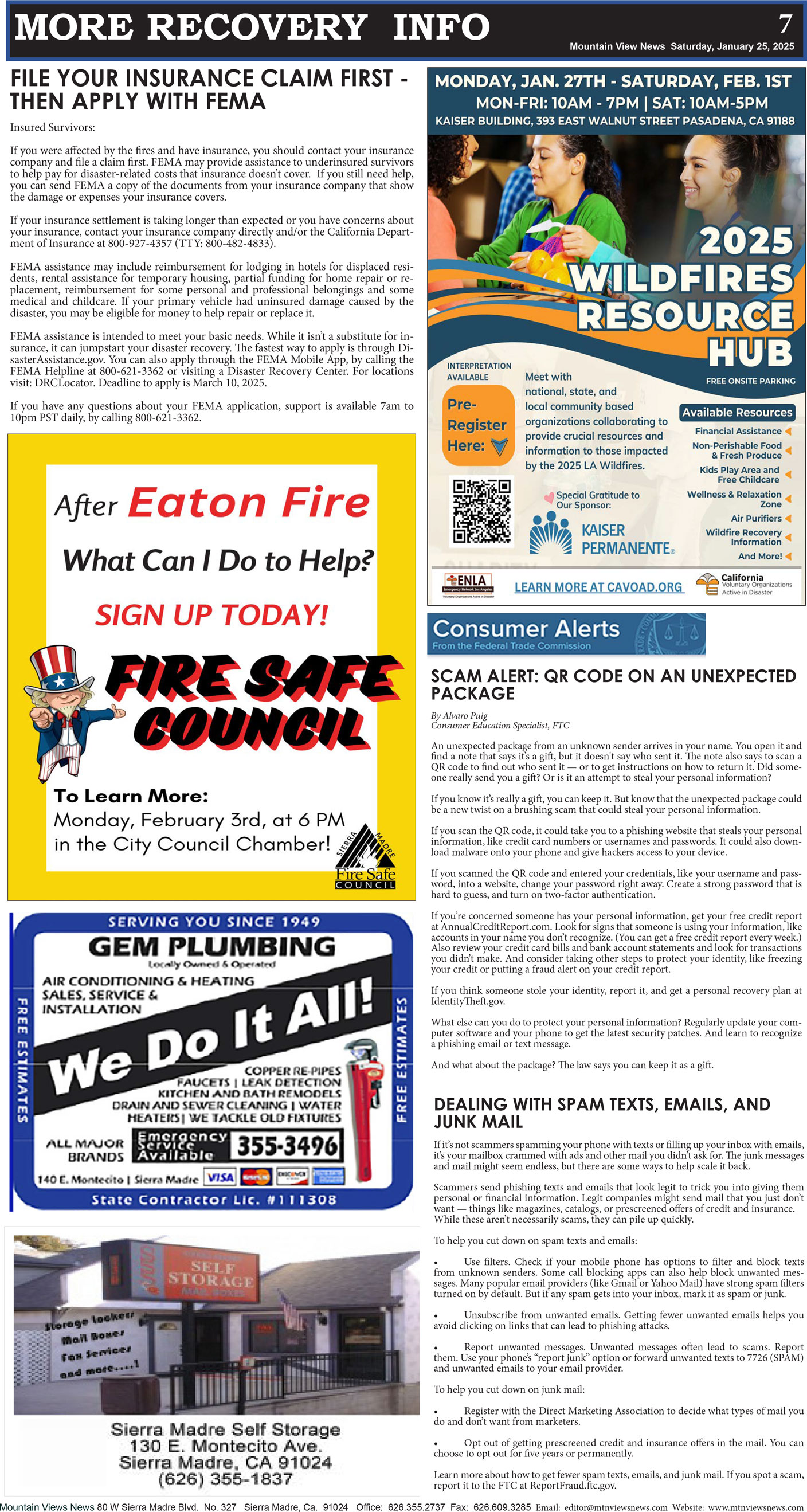
7
MORE RECOVERY INFO
Mountain View News Saturday, January 25, 2025
FILE YOUR INSURANCE CLAIM FIRST -
THEN APPLY WITH FEMA
Insured Survivors:
If you were affected by the fires and have insurance, you should contact your insurance
company and file a claim first. FEMA may provide assistance to underinsured survivors
to help pay for disaster-related costs that insurance doesn’t cover. If you still need help,
you can send FEMA a copy of the documents from your insurance company that show
the damage or expenses your insurance covers.
If your insurance settlement is taking longer than expected or you have concerns about
your insurance, contact your insurance company directly and/or the California Department
of Insurance at 800-927-4357 (TTY: 800-482-4833).
FEMA assistance may include reimbursement for lodging in hotels for displaced residents,
rental assistance for temporary housing, partial funding for home repair or replacement,
reimbursement for some personal and professional belongings and some
medical and childcare. If your primary vehicle had uninsured damage caused by the
disaster, you may be eligible for money to help repair or replace it.
FEMA assistance is intended to meet your basic needs. While it isn’t a substitute for insurance,
it can jumpstart your disaster recovery. The fastest way to apply is through DisasterAssistance.
gov. You can also apply through the FEMA Mobile App, by calling the
FEMA Helpline at 800-621-3362 or visiting a Disaster Recovery Center. For locations
visit: DRCLocator. Deadline to apply is March 10, 2025.
If you have any questions about your FEMA application, support is available 7am to
10pm PST daily, by calling 800-621-3362.
SCAM ALERT: QR CODE ON AN UNEXPECTED
PACKAGE
By Alvaro Puig
Consumer Education Specialist, FTC
An unexpected package from an unknown sender arrives in your name. You open it and
find a note that says it’s a gift, but it doesn't say who sent it. The note also says to scan a
QR code to find out who sent it — or to get instructions on how to return it. Did someone
really send you a gift? Or is it an attempt to steal your personal information?
If you know it’s really a gift, you can keep it. But know that the unexpected package could
be a new twist on a brushing scam that could steal your personal information.
If you scan the QR code, it could take you to a phishing website that steals your personal
information, like credit card numbers or usernames and passwords. It could also download
malware onto your phone and give hackers access to your device.
If you scanned the QR code and entered your credentials, like your username and password,
into a website, change your password right away. Create a strong password that is
hard to guess, and turn on two-factor authentication.
If you’re concerned someone has your personal information, get your free credit report
at AnnualCreditReport.com. Look for signs that someone is using your information, like
accounts in your name you don’t recognize. (You can get a free credit report every week.)
Also review your credit card bills and bank account statements and look for transactions
you didn’t make. And consider taking other steps to protect your identity, like freezing
your credit or putting a fraud alert on your credit report.
If you think someone stole your identity, report it, and get a personal recovery plan at
IdentityTheft.gov.
What else can you do to protect your personal information? Regularly update your computer
software and your phone to get the latest security patches. And learn to recognize
a phishing email or text message.
And what about the package? The law says you can keep it as a gift.
DEALING WITH SPAM TEXTS, EMAILS, AND
JUNK MAIL
If it’s not scammers spamming your phone with texts or filling up your inbox with emails,
it’s your mailbox crammed with ads and other mail you didn’t ask for. The junk messages
and mail might seem endless, but there are some ways to help scale it back.
Scammers send phishing texts and emails that look legit to trick you into giving them
personal or financial information. Legit companies might send mail that you just don’t
want — things like magazines, catalogs, or prescreened offers of credit and insurance.
While these aren’t necessarily scams, they can pile up quickly.
To help you cut down on spam texts and emails:
• Use filters. Check if your mobile phone has options to filter and block texts
from unknown senders. Some call blocking apps can also help block unwanted messages.
Many popular email providers (like Gmail or Yahoo Mail) have strong spam filters
turned on by default. But if any spam gets into your inbox, mark it as spam or junk.
• Unsubscribe from unwanted emails. Getting fewer unwanted emails helps you
avoid clicking on links that can lead to phishing attacks.
• Report unwanted messages. Unwanted messages often lead to scams. Report
them. Use your phone’s “report junk” option or forward unwanted texts to 7726 (SPAM)
and unwanted emails to your email provider.
To help you cut down on junk mail:
• Register with the Direct Marketing Association to decide what types of mail you
do and don’t want from marketers.
• Opt out of getting prescreened credit and insurance offers in the mail. You can
choose to opt out for five years or permanently.
Learn more about how to get fewer spam texts, emails, and junk mail. If you spot a scam,
report it to the FTC at ReportFraud.ftc.gov.
Mountain Views News 80 W Sierra Madre Blvd. No. 327 Sierra Madre, Ca. 91024 Office: 626.355.2737 Fax: 626.609.3285 Email: editor@mtnviewsnews.com Website: www.mtnviewsnews.com
|